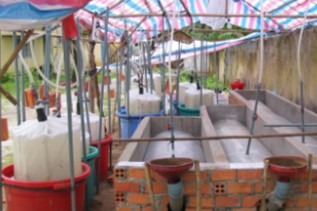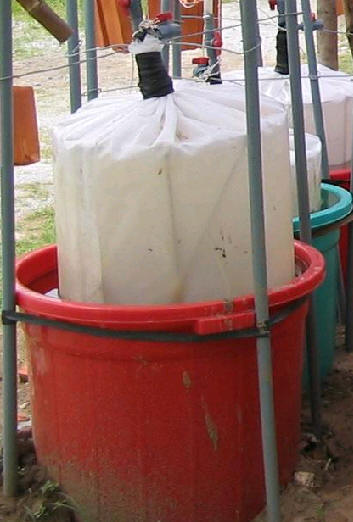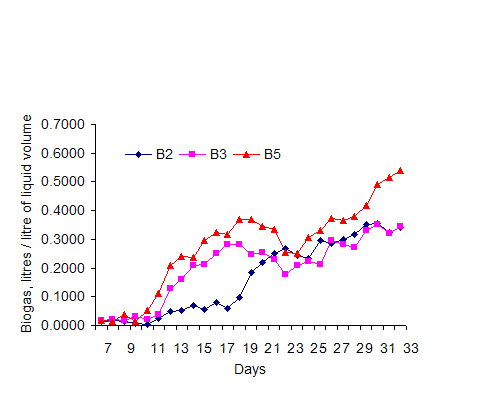Effect of dimensions of plastic biodigester (width:length ratio) on gas production and composition of effluent
Bui Phan Thu Hang
Cantho University, Vietnam
hang.ctu@mekarn.org;
hanglam243@yahoo.com
Abstract
An experiment was conducted in order to compare the effect of
the dimensions of plastic biodigesters (width:length ratio) on gas
production and composition of effluent. The experiment had three
treatments consisting of different dimensions of plastic
biodigester: 2, 3 and 5 m length and 64 cm diameter. Fresh cow
manure at a loading rate of 4 kg DM/m3 of liquid
capacity was charged daily into each biodigester. The manure was
mixed with 11.4, 17.1 and 28.5 litres of water in biodigesters 2, 3, and
5 m long, respectively, to give a retention time of 20 days. Biogas
production was measured daily by water displacement in inverted
light-weight containers suspended in 200 litre drums filled with
water.
Gas production progressively increased with time
in all three biodigesters and after 30 days was 55% of the liquid volume for the
5m biodigester compared with 33% for the 2 and 3m biodigesters. There was no
apparent effect of biodigester dimension on chemical
characteristics of the effluent, with overall means of 3.59% for
DM, 77.4% for organic matter in DM, 6.59 for pH and 967 mg N/litre,
respectively. Ammonia content in the effluent was on average 391
mg/litre, accounting for 41.1% of total N.
It is concluded that a length:diameter ratio of 5:0.65 is better than ratios of 2:0.65 or 3:0.65 for the construction of plug flow tubular plastic biodigesters.
Key words: biodigester, cow manure, dimension,, effluent, gas production, nitrogen
Introduction
The human population continues to increase in developing countries, creating increasing demand for animal products. Thus the animal production in developing countries has also increased very quickly, and as a result more manure is produced. Biological water pollution by waste water from the animal excreta is an emerging problem in rural parts of the Mekong delta. Many households there are still using river and canal water as drinking water directly or with insufficient treatment such as sedimentation. People commonly use the water for washing dishes, clothes and their bodies. Livestock production continuously increased will result in the dramatic accumulation of livestock wastes at present and in the future, which will become a more serious problem. Thus, it is necessary to encourage animal farms to treat waste water (Tran Thi Phan and Takeshi Watanabe 2002).
To solve the problem of pollution from the animal excreta, there are some ways that can be applied at present. The plastic biodigester is one of the most efficient technologies for small scale animal farms because of its low cost, fast payback, simplicity and positive effect on pollution (Bui Xuan An et al 1999; Khang et al 2002a). Besides environmental preservation, gas production for cooking reduces the need for firewood and also labor for finding other fuels. Biodigester effluent can be applied to crops (cassava, rice field, and other perennial crops), vegetables (salad, water spinach, tomatoes and cabbage) and in ponds (fish or water plants). In this connection, Ly Thi Luyen (2003), Ho Bunyeth (2003) and Kean Sophea et al (2001) reported that water spinach yields responded linearly to increasing levels of nitrogen in effluent from biodigesters charged with pig manure.
The plastic biogas digester is a means of generating biogas and organic fertilizer from human and livestock excreta through anaerobic fermentation (Vo Lam et al 2002). However, retention time, the dimensions of the plastic biodigester, and type of manure, amongst others, all have an effect on gas production and composition of the effluent. Most fermentation tubes are of approximately 1m in diameter and 10 m length, which is a length:diameter ratio of 10:1. Recent researches have shown that gas yields are high (almost 100% of biodigester liquid volume) in small biodigesters with a length:diameter ratio of 3:1 (San thy et al 2003).
Therefore, the working hypothesis was that gas yields, as a function of digester liquid volume will be higher, and there will be greater conversion of organic to ammonia-N, when the length: diameter ratio is decreased.
Objectives
- To identify the suitable ratio of length and diameter in plastic, tubular biodigesters, in order to obtain a higher gas production
- To determine chemical characteristics of effluents from biodigesters with different length:diameter ratios
Hypotheses
Gas yields as a function of digester liquid volume will be higher, and
there will be greater conversion of organic to ammonia-N, when the
length: diameter ratio is decreased.
Materials and methods
Location and experimental length
The experiment was carried out in Angiang University, Vietnam from July 29, 2003 to August 30, 2003
Experimental treatments
Three biodigesters were made from tubular polyethylene film (internal diameter 0.64 m), enclosed in brick walls (Photo 1), with internal measurements of 60 cm wide and 70 cm high to ensure the correct dimensions of the digesters, and to provide a liquid volume in the proportion of 75% of biodigester volume. The dimensions of the biodigesters were:
- B2: plastic biodigester 2 m long and 64 cm diameter
- B3: plastic biodigester 3 m long and 64 cm diameter
- B5: plastic biodigester 5 m long and 64 cm diameter
The biodigesters were initially inoculated with effluent from a working biodigester, cattle manure and water (Table 1). The manure was collected from Vamcong farm, Angiang province, Vietnam. A constant loading rate (4 kg manure DM per 1m³ digester liquid volume) was applied to all 3 biodigesters (Tables 2 and 3). The fresh manure was previously mixed with enough water so as to ensure a retention time of 20 days.
|
Table 1. Inoculation of biodigesters according to proportion of biodigester volume |
|||
|
|
2 m |
3 m |
5 m |
|
Manure, kg |
98 |
146 |
244 |
|
Water, litres |
294 |
438 |
732 |
|
Total, litres |
392 |
584 |
976 |
|
Effluent, litres |
110 |
165 |
275 |
|
Total, litres |
502 |
749 |
1250 |

Photo 1: The biodigesters
The amounts of manure and water added to the biodigesters are shown in Table 2.
|
Table 2. Technological parameters of the experimental biodigesters |
|||
|
Constants |
|
|
|
|
Plastic width, m |
1 |
|
|
|
Circumference, m |
2 |
|
|
|
Internal diameter, m |
0.64 |
|
|
|
Loading rate, kg/m3 |
4 |
|
|
|
The range of DM of the manure, % |
13.9 to 17.2 |
|
|
|
Average manure DM, % |
15.3 |
|
|
|
Retention time, days |
20 |
|
|
|
|
B2 |
B3 |
B5 |
|
Biodigester length, m |
2 |
3 |
5 |
|
Volume, litres |
637 |
955 |
1592 |
|
Liquid volume, % |
75 |
75 |
75 |
|
Liquid volume, litres |
477 |
716 |
1194 |
|
Daily input, litres |
23.9 |
35.8 |
59.7 |
|
Manure, kg DM/day |
1.9 |
2.9 |
4.8 |
|
Manure, kg fresh matter/day |
12.5 |
18.7 |
31.2 |
|
Water, litres/day |
11.4 |
17.1 |
28.5 |
Measurements
Gas production was measured daily by collecting the gas using inverted plastic tubes of 50 cm diameter permanently connected to the gas outlet (Photo 2), supported inside with a bamboo frame, and suspended in drums filled with water (Santhy et al 2003). Measurements were done three times per day. Samples of fresh cow manure and effluent were obtained daily on days 21 to 26, and analyzed for DM, total N, ammonia-N and pH. The first 20 days of the experiment were for adaptation. Total N and ammonia were determined by Kjeldahl procedures (AOAC 1990). DM content was determined by microwave radiation (Undersander et al 1993), and the pH by glass electrode.

Photo 2. Inverted container for biogas collection by water
displacement
Statistical analysis
There was only one replicate from each treatment as this was a pilot
observation to find out if the configuration is a factor
determining the performance of the biodigester.
Results and discussion
Manure and slurry input
Some data on the composition of the manure are in Table 3.
|
Table 3. Manure and slurry input characteristics |
||
|
|
Manure |
Slurry input |
|
DM, % |
15.3 |
4.02 |
|
Organic matter, % |
83.6 |
82.2 |
|
pH |
7.19 |
6.96 |
|
Total N, mg/kg |
3730 |
1550 |
|
NH3-N, mg/kg |
640 |
360 |
|
NH3-N in total N, % |
17.2 |
23.1 |
Biogas production
A leakage of gas from biodigester 2 was observed during the second week of adaptation and it was decided to replace the plastic. The replacement operation took about 4 hours. The contents of the original biodigester were retained and re-introduced into a new plastic tube; however, gas production was reduced and it required a further 7 days before returning to normal. Gas production, as proportion of biodigester liquid volume , was similar for all three biodigester dimensions during the adaptation period. However, from day 23 onwards it appeared to be considerably higher for the 5m biodigester (Figure 1). Efficiency of conversion of manure organic matter to biogas was also higher for the longer biodigester (Table 1). There was a greater conversion of organic to ammonia-N during 33 days of the experiment, according to the increase in length:diameter .
|
Table 4. Mean values for biogas production (days 11 to 33) in biodigesters with different dimension ratios (length: diameter) |
|||||
|
|
2m |
3m |
5m |
SEM |
Probability |
|
Biogas production |
|
|
|
|
|
|
Litres/day |
79.8b |
144b |
332a |
23.0 |
0.001 |
|
Litres/liquid volume |
0.17b |
0.20ab |
0.28a |
0.025 |
0.008 |
|
Litres/kg DM manure |
55.0b |
65.8ab |
91.2a |
8.311 |
0.009 |
|
Litres/kg OM |
66.5b |
79.6ab |
110.5a |
10.06 |
0.009 |
|
% of liquid volume |
16.7b |
20.1ab |
27.8a |
2.53 |
0.009 |
|
Air temperature at time of day: |
6:30 |
12:00 |
18:30 |
- |
- |
|
Average, oC |
26.5 |
34.5 |
28.3 |
- |
|

Figure 1. Effect of length of plastic
tubular biodigester on gas production
Several investigation have been undertaken to find the optimum conditions for biogas production. In this connection, Khang et al (2002b) studied different concentrations of manure in the input slurry (1, 2, 3 and 4%) of DM and various retention times (10, 20, 30 and 40 days), and reported that the highest gas yield was with 4% DM. These experiments indicated that retention time was a factor influencing efficiency of gas production, the longer retention time resulting in higher efficiencies. The reported value of 426 litres/kg DM manure for 40 days of retention time was much higher than in the present experiment. However, Khang et al (2002b) used pig manure which is known to be superior to cattle manure for biogas production.
In a survey of low-cost polyethylene tube biodigesters in small-scale farms in Vietnam, with a mean length of 10.2 m and a loading rate of 0.7 kg DM manure/m3 (range from 0.1 to 1.2 kg DM manure/m3), on average the gas production was 1235 litres/day, equivalent to in the range from 689-2237 litres/unit/day (Bui Xuan An et al 1997).
The average atmospheric temperature ranged from 26.5 to 34.5oC (Table 3). Fair and Moor (1937, cited by Gunnerson and Stuckey 1986), suggested that this range of temperature is suitable for mesophilic bacteria.
Effluent characteristics
DM and organic matter values in the effluent were not affected by the dimensions of the biodigesters (Table 4). These results were similar to other studies conducted with biodigesters in Vietnam, with an input slurry concentration from 2 to 8% DM and a loading rate of 0.1 to 1.2 kg DM/m3 liquid volume (Bui Xuan An et al 1997).
|
Table 4. Effect of dimensions of biodigester on composition of the effluent |
|||||
|
|
2m |
3m |
5m |
SEM |
Probability |
|
Dry matter, % |
3.48 |
4.08 |
3.21 |
0.76 |
0.71 |
|
Organic matter, % |
78.3 |
79.5 |
74.7 |
2.88 |
0.48 |
|
pH |
6.43 |
6.7 |
6.64 |
0.08 |
> 0.05 |
|
Total N, mg/kg |
916 |
983 |
1004 |
0.01 |
0.86 |
|
NH3-N, mg/kg |
346 |
423 |
406 |
0.005 |
0.53 |
|
NH3-N in total N, % |
40.1 |
42.1 |
41.4 |
3.1 |
0.89 |
It is generally recommended that the pH inside the biodigester should be above 7 for maximum gas production. In the present study, the pH was in the range from 6.43 to 6.7 (Table 4). Safley et al (1987) used poultry manure in a biodigester with a hydraulic retention time of 22 days at 35oC, and observed an average pH of 7.2. According to Khang et al (2002b), pH values in the range of 6.98 to 7.02, and were not affected by different retention times (10 to 40 days). Fischer et al (1979) studied methane production from swine manure in a pilot-size digester, and obtained pH values in the effluent of 6.5 to 7.6 at 35oC with a hydraulic retention time of 15 days. Bui Xuan An et al (1997) reported a pH from 6.8 to 7.5, with biodigesters of an average length of 10.2 m and a loading rate of 0.7 kg DM manure/m3.
Total N and ammonia N, and the ratio of ammonia N to total N were not affected by biodigester dimension. Santhy et al (2003), using pig manure with loading rates of 2.93, 1.46 and 0.92 kg DM/day/m³ liquid volume and hydraulic retention time of 10, 20, and 30 days, observed that the proportion of ammonia N to total N increased with longer retention time. Safley et al (1987), with a hydraulic retention time of 22 days at 35oC, encountered average ammonia N and total N values of 4261 mg/kg and 5318 mg/kg, respectively.
Conclusions
- The gas production in a plastic tubular biodigester of 5 m length was higher than in others of a shorter length (2 and 3 m).
- Ammonia-N as percentage of total N in the effluent was 40% and not affected by biodigester dimension
Acknowledgements
This experiment was supported by the MEKARN project, financed by SIDA-SAREC Agency. First of all, I would like to express my
appreciation to Dr Preston, Dr Ly, Mr Santhy, Mr Chayty for their
help and encouragement. I wish also to
express my great thanks to Dr. Vo Tong Xuan and D Vo Tong Anh and all of the staff of the Faculty of Agriculture, An Giang
University, Vietnam, who facilitated the study.
Finally, I also thank my classmates, for their encouragement and
sharing of knowledge acquired through carrying out their mini-projects.
References
AOAC 1990 Official Method of Analysis. Association of
Official Analytical Chemical .15th edition (K Helrick
editor) Arlington, pp1230
Bui Xuan An, Preston T R and Dolberg F 1997
The introduction of low-cost polyethylene tube biodigesters on
small scale farms in Vietnam. Livestock Research for Rural
Development 9(2): http://www.cipav.org.co/lrrd/lrrd9/2/an92.htm
Duong Nguyen Khang and Le Anh Tuan 2002a The result of
the low plastic film biodigester technology transferring at University of Agriculture and Forestry, Ho Chi Minh. Proceeding of
the 2002 International Workshop on the recent developments in
recycling of livestock wastes through biodigesters and water plants.
March 10-11, 2002. University of Agriculture and Forestry, Ho Chi
Minh city, Vietnam.
Duong Nguyen Khang, Le Anh Tuan, and TR Preston 2002b
The effect of fiber level in feedstock, loading rate and
retention time on the rate of biogas production in plug-flow and
liquid displacement biodigesters. Proceedings biodigester Workshop.
http://www.mekarn.org/procbiod/Khang.htm
Fischer J R, Iannotti, E L, Porter J H and Garcia A 1979. Producing Methane gas from Swine manure in a Pilot-size digester, Transaction of the ASAE.
Ho Bunyeth 2003: Biodigester effluent as fertilizer
for water spinach established from seed or from cuttings; Retrieved,
from MEKARN Mini-projects.
Ly Thi Luyen
Safley J R, Vetter R L and Smith L D 1987. Management and
Operation of a full scale poultry waste digester. Poultry Science
66:941-945
San Thy, PrestonT R and Ly J 2003 Effect of
retention time on gas production and fertilizer value of
biodigester effluent. Livestock Research for Rural
Development (15) 7, http://www.cipav.org.co/lrrd/lrrd15/7/sant157.htm
Tran Thi Phan and Takeshi Watanabe 2002
Development of the new technologies and their practice for
sustainable farming systems in the Mekong Delta. Proceeding of the
2002 Annual Workshop of JICAS Mekong Delta Project. November 26-28,
2002. College of Agriculture, CanthoUniversity.
Vietnam.
Undersander D, Mertens D R and Thiex N 1993 Forage
analysis procedures. National Forage Testing Association. Omaha, pp
164
Vo Lam and Takeshi Watanabe 2002 Development of the
new technologies and their practice for sustainable farming systems
in the Mekong Delta. Proceeding of the 2002 Annual Workshop of
JICAS MekongDelta Project. November 26-28, 2002. Collegeof
Agriculture, CanthoUniversity. Vietnam.
Yongfu Y, Yibo Q, Hui Z, Yuansheng X, Chenyong X, Guoyuan F, Jienquan X, Taiming Z and Gan L 1989. The biogas technology in China. Agricultural Pub House, Beijing.
Go to top